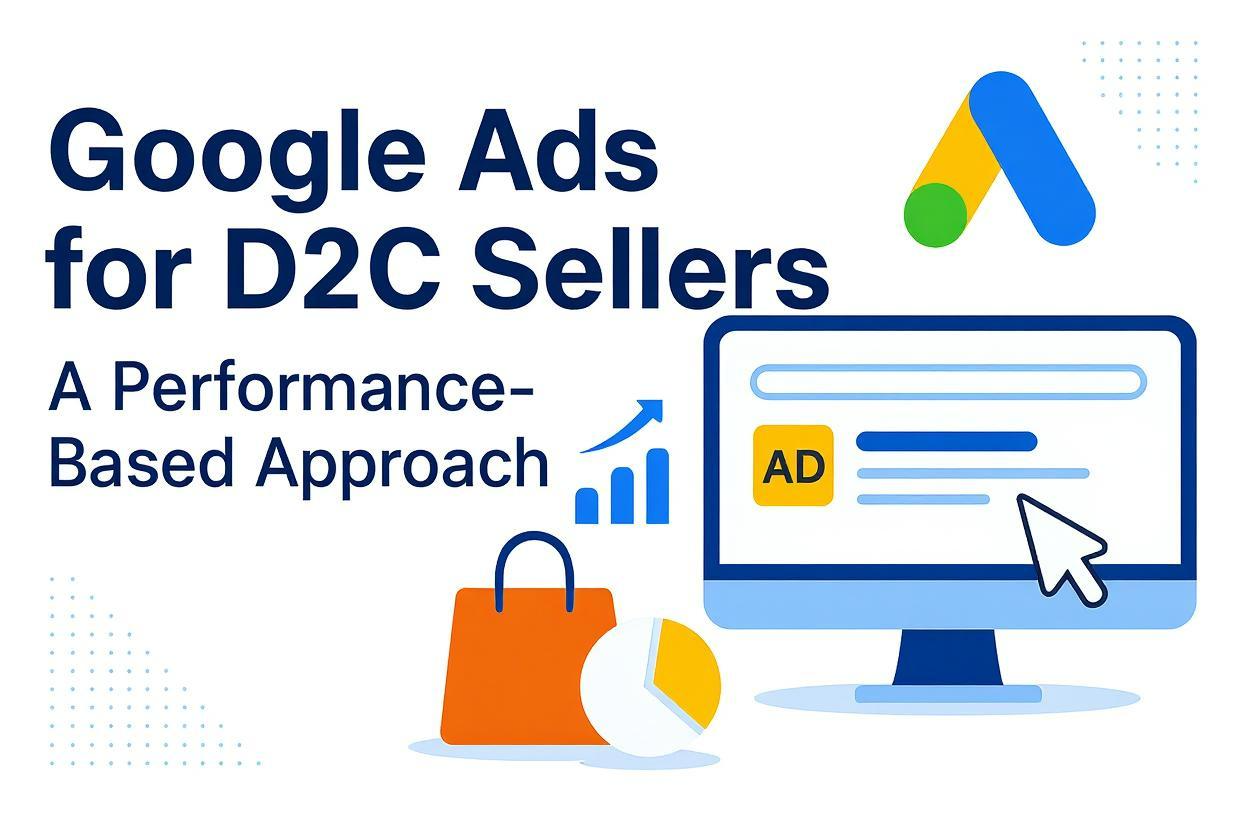
Introduction:
If you’re running a D2C brand and not leveraging Google Ads, you’re missing out on intent-rich traffic. Google Ads – especially Shopping and Search – target buyers who are already looking to purchase, making them one of the highest-converting ad platforms when optimized correctly.
In this guide, we’ll break down a performance-first strategy for using Google Ads to scale your D2C store profitably in 2025.
Why Google Ads Are Crucial for D2C Brands
| Feature | Why It Matters |
|---|---|
| Purchase Intent | Users are searching for products directly |
| Visual Product Display | Shopping Ads show images, price, reviews upfront |
| Brand Visibility | Appear in top search spots — even over Amazon |
| Cross-Channel Impact | Boosts branded traffic on Meta + Amazon |
Start with the Right Campaign Types
1. Performance Max Campaigns
A fully automated, AI-driven format that runs across:
-
Search
-
Shopping
-
YouTube
-
Gmail
-
Display
Best for: Full-funnel performance – especially if you already have sales history or a strong product catalog.
Tip: Feed Google with high-quality product titles, images, reviews, and videos to increase ROAS.
2. Search Campaigns (Branded + Non-Branded)
| Campaign Type | Target Keyword Examples | Purpose |
|---|---|---|
| Branded | “veda roots maca capsules” | Capture known traffic |
| Generic | “organic vitality supplements” | Acquire new customers |
| Competitor | “xyz brand sea moss capsules” | Steal competitor share |
Use exact and phrase match with SKAGs (single keyword ad groups) for best results.
3. Shopping Campaigns (Standard + Smart)
These show your products in search results with image + price.
Best for:
-
Visual products (e.g., supplements, lifestyle)
-
Mobile-first traffic
-
High click-through intent
Use Product Feed Optimization tools like DataFeedWatch or Feedonomics to improve performance.
Ad Copy That Converts (For Search Campaigns)
| Element | What to Include |
|---|---|
| Headline 1 | Product name or use case (e.g., “Organic Ashwagandha”) |
| Headline 2 | Benefit or differentiator (e.g., “Stress Relief Blend”) |
| Headline 3 | Offer or urgency (“20% OFF |
| Description | Highlight certifications, usage, and USP |
Always A/B test ads using Responsive Search Ads (RSA).
Optimize Your Product Feed for Google Shopping
Google Shopping relies heavily on your product feed quality.
Optimize These Fields:
-
Title: “Organic Maca Root Capsules – 120 Veg Caps for Energy & Vitality”
-
Description: List key benefits, ingredients, certifications
-
Product Type: Use detailed taxonomy
-
GTIN / MPN: Mandatory for most categories
-
Image: Clear white background with real product
Use merchant center diagnostics weekly to avoid disapprovals.
Retargeting Setup
Use Dynamic Remarketing to show ads to past visitors:
| Audience Segment | What to Show |
|---|---|
| Cart abandoners | Product they left + discount |
| Product viewers | Carousel of related products |
| Repeat buyers | Complementary SKUs or subscriptions |
Also use Customer Match to target your email list via Gmail, YouTube, and Search.
Tracking and Performance Metrics
Use conversion tracking via:
-
Google Tag Manager
-
Google Ads conversion pixel
-
Google Analytics 4 (GA4) with enhanced eCommerce
Track:
| Metric | Benchmark Goal |
|---|---|
| ROAS | > 3x |
| CTR | 3–5% (Search), 1–2% (Shopping) |
| Conversion Rate | 2.5–5% |
| Bounce Rate | < 40% |
Tools to Use for Google Ads Success
-
Google Merchant Center – Manage product feeds
-
Feedonomics / Simprosys – Feed optimization
-
Keyword Planner / SEMrush – Keyword research
-
Hotjar / Clarity – Post-click optimization
-
eCommercean Ad Dashboard – See Amazon vs D2C ROI in one view
Bonus: Combine with Amazon Attribution
If you’re running Shopping Ads and notice people switching to Amazon:
-
Create Amazon Attribution links for your ads
-
Add “Also available on Amazon” in Search Ad extensions
-
Track whether Google traffic converts better on your site or Amazon
Then adjust your funnel accordingly.
Conclusion:
Google Ads aren’t just about visibility – they’re about intent, timing, and conversions. With smart structure, optimized feeds, and performance-focused creatives, you can turn Google into your most profitable D2C traffic source.
Need a done-for-you setup or a playbook to manage it yourself? Try eCommercean’s Google Ads Strategy Kit — built specifically for scaling Shopify + Amazon brands.
